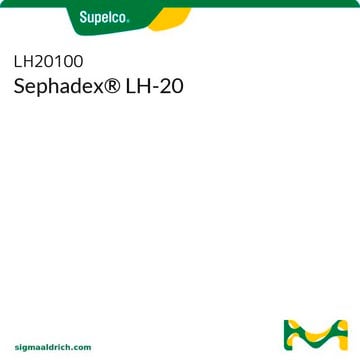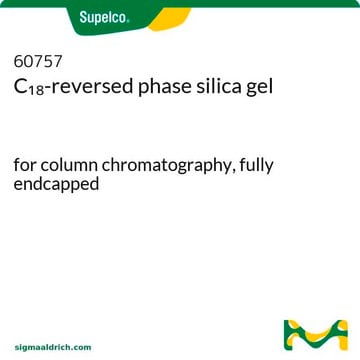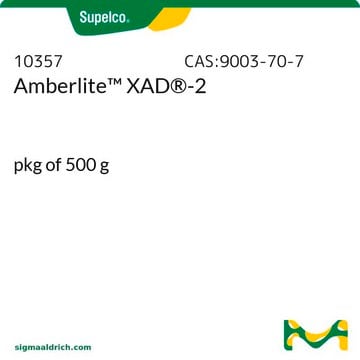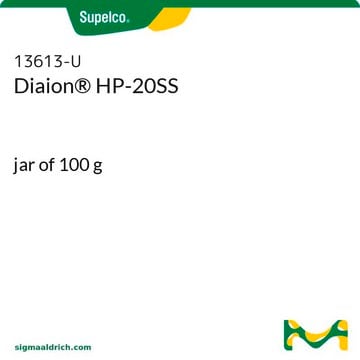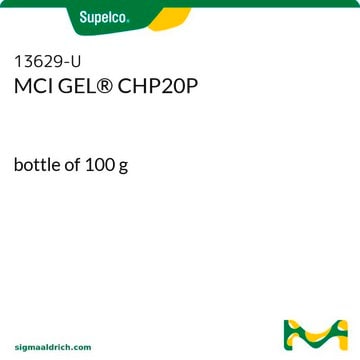Products may be shipped at a different temperature than the recommended long-term storage temperature. If the product quality is sensitive to short-term exposure to conditions other than the recommended long-term storage, it will be shipped on wet or dry-ice. If the product quality is NOT affected by short-term exposure to conditions other than the recommended long-term storage, it will be shipped at ambient temperature. As shipping routes are configured for minimum transit times, shipping at ambient temperature helps control shipping costs for our customers. For more information, please refer to the Storage and Transport Conditions document: https://www.sigmaaldrich.com/deepweb/assets/sigmaaldrich/marketing/global/documents/316/622/storage-transport-conditions-mk.pdf
13606
Diaion® HP-20
pkg of 500 g
About This Item
Produits recommandés
Forme
solid
Conditionnement
pkg of 500 g
Technique(s)
HPLC: suitable
LPLC: suitable
ion chromatography: suitable
thin layer chromatography (TLC): suitable
Superficie
~500 m2/g
Matrice
styrene-divinylbenzene
Groupe de la matrice active
polymer
Taille des particules
250-850 μm
Dimension de pores
~1.30 mL/g pore volume
260 Å mean pore size
Densité
1.01 g/mL at 25 °C (true wet)(lit.)
Technique de séparation
reversed phase
Chaîne SMILES
C(C)c3c(cccc3)C=C.c2(c(cccc2)C=C)C=C.c1(ccccc1)C=C
InChI
1S/C10H12.C10H10.C8H8/c2*1-3-9-7-5-6-8-10(9)4-2;1-2-8-6-4-3-5-7-8/h3,5-8H,1,4H2,2H3;3-8H,1-2H2;2-7H,1H2
Clé InChI
NWUYHJFMYQTDRP-UHFFFAOYSA-N
Vous recherchez des produits similaires ? Visite Guide de comparaison des produits
Catégories apparentées
Description générale
Application
Autres remarques
Informations légales
Code de la classe de stockage
11 - Combustible Solids
Classe de danger pour l'eau (WGK)
WGK 3
Point d'éclair (°F)
Not applicable
Point d'éclair (°C)
Not applicable
Équipement de protection individuelle
Eyeshields, Gloves, type N95 (US)
Faites votre choix parmi les versions les plus récentes :
Déjà en possession de ce produit ?
Retrouvez la documentation relative aux produits que vous avez récemment achetés dans la Bibliothèque de documents.
Les clients ont également consulté
-
How is shipping temperature determined? And how is it related to the product storage temperature?
1 réponse-
Utile ?
-
-
How can I determine the shelf life / expiration / retest date of this product?
1 réponse-
If this product has an expiration or retest date, it will be shown on the Certificate of Analysis (COA, CofA). If there is no retest or expiration date listed on the product's COA, we do not have suitable stability data to determine a shelf life. For these products, the only date on the COA will be the release date; a retest, expiration, or use-by-date will not be displayed.
For all products, we recommend handling per defined conditions as printed in our product literature and website product descriptions. We recommend that products should be routinely inspected by customers to ensure they perform as expected.
For products without retest or expiration dates, our standard warranty of 1 year from the date of shipment is applicable.
For more information, please refer to the Product Dating Information document: https://www.sigmaaldrich.com/deepweb/assets/sigmaaldrich/marketing/global/documents/449/386/product-dating-information-mk.pdfUtile ?
-
-
What king of column can be used for this resin? Could you please explain how to plug the column glass tube? My guess is that a cotton plug and sand will not work well with backflow which is recommended for this resin.
1 réponse-
A gravity column is suitable for use with this resin. Product Z163961-1EA is an example of a gravity column. The glass column does not have a frit, so a glass-wool plug and sand are used. To plug the column, gently insert the glass-wool plug from the column top and push it down the column gently using a glass rod.
Utile ?
-
Filtres actifs
Notre équipe de scientifiques dispose d'une expérience dans tous les secteurs de la recherche, notamment en sciences de la vie, science des matériaux, synthèse chimique, chromatographie, analyse et dans de nombreux autres domaines..
Contacter notre Service technique